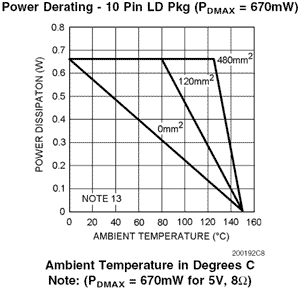|
Research Assignment:
- Using the application information from AN-1192, locate and use the equations for maximum power dissipation (PDMAX), calculate (PDMAX) for a mono single ended amplifier if VDD=5V and RL=8 Ohms (nearest mW). check answer
- Using the same conditions in question 1 determine the PDMAX for a mono BTL-mode amplifier. check answer
Graph 1

Explanation: Power derating curves are used to ensure that the device's maximum junction temperature (TJMAX) is not exceeded (See Graph 1). The curves usually require knowledge of two out of three variables: PDMAX, Maximum Ambient Temperature, and heat sink size. The unknown variable is determined using the two known variables.
Note: The measured device dissipation (PDMAX) is slightly higher than the calculated value because of quiescent supply current. This can be illustrated by comparing a calculated PDMAX with the PDMAX shown in a datasheet graph.
For example:
You want to determine the maximum ambient operating temperature for our LM4890, 5V, BTL amplifier.
Conditions: VDD = 5V
BTL connection
RL = 8 Ohms
Heat sink = 120mm2
Package = 10pin LD
PDMAX:
Calculated = 633mW
From Graph = 670mW (See Graph 2)
Answer: As graph 3 illustrates, the maximum ambient temperature = 80 degrees C
| 